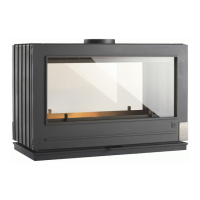Energy Distribution 2015 REVISION JULY 2020
24
TROUBLESHOOTING GUIDE
Slightly crack the door one minute before fully opening doors.
Cold Chimney or reverse
draft
Preheat the chimney when first starting a fire. Briefly open a
window in the room containing the stove.
Examine the chimney and stovepipe for blockage or creosote
accumulations.
Reline the chimney to the appropriate diameter
Install a draft inducer or replace the chimney.
Air Infiltration into The
Chimney
Seal chimney connections and openings. Check clean-out
doors.
Ensure cordwood is seasoned and dry.
More Than One
Appliance Connected to
the Flue
Disconnect all other appliances and seal openings.
BACK-PUFFING
OR GAS
EXPLOSIONS
Slightly crack door one minute before fully opening the door
and keep it fully open for a few minutes after reloading.
Empty the ash pan more frequently. Increase efficiency of
burns, and avoid using poor quality or green wood.
UNCONTROLLED
OR SHORT
BURN
Close the door tightly or replace the gaskets.
Air leakage around glass gasket – replace gasket
Check the installation. Install stovepipe damper. Draft in excess
of 0.1 wc should be corrected with a stovepipe damper(s)
Shorten the chimney. Install stovepipe damper(s).
Reline the chimney to the proper diameter.
High Winds or Hilltop
Location:
Poor Quality, low Btu
content, or Green Wood
Use only air-dried wood, preferably dried at least one year. Use
a wood with a high Btu content if available.
Reline or insulate the chimney.
Leaky Stovepipe or
Chimney
Check the installation. Replace with a pre-fabricated insulated
chimney system or a properly sized masonry chimney.
Too Much Heat Loss
From House
Add insulation, use energy efficient windows, or caulk windows,
and seal openings in home.
Empty the ash pan more frequently. Increase efficiency of
burns, and avoid using poor quality or green wood.
Do not over-fire the stove. Monitor stove temperatures. Use
seasoned wood only.
Check the DRAFT. A damper may be required. Operate the
stove at a LOW BURN range.

